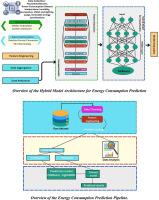Analyzing energy consumption trends and environmental influences: A time-series study on temperature, renewables, and demand correlations
引用次数: 0
Abstract
This study investigates energy consumption trends and environmental influences by analyzing time-series data to explore the correlation between temperature, humidity, renewable energy contributions, and energy demand. The research focuses on developing an advanced hybrid machine learning model using LightGBM, XGBoost, LSTM, and SHAP to enhance the accuracy and interpretability of energy consumption predictions. Using data from January 2022 to January 2025 across residential, commercial, and industrial buildings, the study examines the impact of temperature fluctuations, humidity, and renewable energy integration on energy consumption. Temperature dependency is further explored in the study, where it is shown that energy consumption is directly influenced by temperature, with energy use at 20 °C being 2000 kWh, increasing to 3200 kWh at 30 °C (on an annual basis), further confirming the shaped dependency with increased cooling demands during warmer months. Additionally, energy consumption varies significantly across building types, with industrial buildings showing higher and more stable energy demands than residential and commercial buildings. Results indicate that XGBoost provides the best predictive performance, with an RMSE of 118.24 and an R² score of 0.9871, followed by LSTM with an RMSE of 135.86 and an R² score of 0.9752, and Linear Regression with RMSE of 187.76 and an R² score of 0.9672. The hybrid model effectively predicts energy consumption and offers valuable insights into how environmental factors influence energy demands across different building types. The findings contribute to optimizing energy management strategies, improving innovative grid systems, and promoting sustainable building operations while highlighting the role of renewable energy in shaping energy consumption patterns.

分析能源消费趋势和环境影响:温度、可再生能源和需求相关性的时间序列研究
本研究通过分析时间序列数据,探讨温度、湿度、可再生能源贡献和能源需求之间的相关性,探讨能源消费趋势和环境影响。该研究的重点是开发一种先进的混合机器学习模型,使用LightGBM、XGBoost、LSTM和SHAP来提高能耗预测的准确性和可解释性。利用2022年1月至2025年1月住宅、商业和工业建筑的数据,该研究考察了温度波动、湿度和可再生能源整合对能源消耗的影响。研究进一步探讨了温度依赖性,研究表明,能源消耗直接受到温度的影响,20°C时的能源消耗为2000千瓦时,在30°C时(按年计算)增加到3200千瓦时,进一步证实了在温暖月份冷却需求增加的形状依赖性。此外,不同建筑类型的能源消耗差异很大,工业建筑的能源需求比住宅和商业建筑更高,也更稳定。结果表明,XGBoost预测效果最佳,RMSE为118.24,R²评分为0.9871;LSTM预测效果次之,RMSE为135.86,R²评分为0.9752;线性回归预测效果最佳,RMSE为187.76,R²评分为0.9672。混合模型有效地预测了能源消耗,并为环境因素如何影响不同建筑类型的能源需求提供了有价值的见解。研究结果有助于优化能源管理策略,改进创新电网系统,促进可持续建筑运营,同时强调可再生能源在塑造能源消费模式中的作用。
本文章由计算机程序翻译,如有差异,请以英文原文为准。
求助全文
约1分钟内获得全文
求助全文

 求助内容:
求助内容: 应助结果提醒方式:
应助结果提醒方式:


